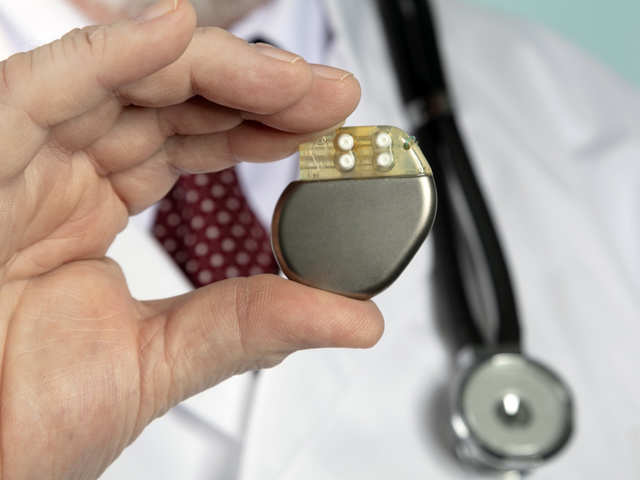- 阅读
- 阅读
- 技巧
- 百科
- 试题
- 文化
- 技能
对那些心脏偶尔没了节奏的人而言,心脏起搏器,毫不夸张地说,就是救生员。
By providing a small electrical jolt at the right moment, they can keep a heart working at the appropriate pace.
通过在恰当时候提供一小撮电流震动,它们可以让心脏以适当的速度保持工作。Their main drawback is that they use batteries. Even the best of them eventually run out of energy, and replacing the batteries requires surgery.
它们主要的缺点就是要用电池。即便是最好的起搏器最终也会耗尽能量,而替换电池需要进行手术。
Since surgery is generally best avoided, the search has been on for long-lasting power sources.
由于最好是避免手术,所以已经在寻找持久的能源。
Various options have been explored, including, in the 1970s, plutonium.
已经开发出了各种选择方案,包括20世纪70年代的钚。
Nuclear-powered pacemakers have thankfully fallen out of fashion and today, devices with lithium batteries last between 5 and 15 years.
还好核能起搏器已经过时了,如今,锂电池设备可以使用5到15年。
Zhang Hao of the Second Military Medical University, in Shanghai,
上海第二军医大学的张浩
and Yang Bin of Shanghai Jiao Tong University sought a way of recharging a pacemaker's battery by scavenging energy from inside the body.
和上海交通大学的杨斌找到了从身体内提供能量给起搏器电池充电的方法。

As they report in the journal ACS Nano they have used the heart muscle itself to power a tiny generator.
如他们在《ACS Nano》期刊中的报告所述,他们利用心脏肌肉为一个微型发电机充电。
Previous attempts to use cardiac muscle power to run pacemakers relied on piezoelectric materials.
之前使用心脏肌肉能量运行起搏器的尝试是依赖于压电材料。
These release electrons when deformed, and can be attached to beating hearts so that they are slightly bent with each heart beat, generating electricity.
这些材料在变形后会释放电子,并且会吸附在跳动的心脏上,因此它们会随着心脏的跳动而弯曲,从而发电。
This has worked, but not well enough: the output has rarely exceeded five microwatts, while most pacemakers require at least ten.
这种方法起作用了,但还不够:发电量仅5微瓦特多一点,而大部分起搏器都需要至少10个微瓦特。
Dr Zhang and Dr Yang speculated that they could improve matters by arranging for their piezoelectric composites to be more dramatically deformed.
张浩和杨斌推测,他们可以通过让压电复合材料更加变形的方法改善这个问题。
First, they created a small capsule from a sheet of flexible polymer a tenth of a millimetre thick.
首先,他们用一种只有十分之一毫米厚的柔性聚合物制作了一颗小胶囊。
After compression, this capsule would return to its original shape.
这颗胶囊被压缩后可以恢复原形。
They then attached strips of piezoelectric composite to either side of the capsule,
然后,他们在胶囊的两边系上了几条压电复合材料
attached electrodes to these strips, and covered the strips with a protective layer of silicone.
压电复合材料中放入了电子,并用硅酮保护层盖住这些材料。
This layout meant that the strips were slightly bent from the beginning and required only a tiny, brief pressure to generate 15 microwatts.
这种设计意味着开始材料会轻微弯曲且仅需要微小短暂的压力就能产生15微瓦特的电。
The question was where to put the capsule, either in or on the heart, in order to get a similar effect.
问题是把这颗胶囊放在哪,要么是放在心脏里边或心脏上边才能获得类似效果。
A study of cardiac anatomy suggested the pericardial sac, at the organ's base, would be ideal.
心脏解剖研究表明心脏底部的围心囊是个理想的放置地点。
It would squeeze the capsule tightly as the heart contracted and still keep a firm grip on it when the heart was relaxed.
它可以随着心脏的收缩轻微挤压胶囊,且在心脏放松时,也能紧紧抓住。
To test this idea, the capsule's electrodes were attached to a commercial pacemaker that had had its battery removed,
为了测试这一想法,胶囊的电极被附在一个电池已被移除的商用起搏器上,
and surgically implanted into a 50kg Yorkshire pig. The capsule generated enough power for the pacemaker to function normally.
并将起搏器通过手术植入一只50公斤的约克夏猪体内。胶囊产生的能量足以让起搏器正常运转。
Whether such an arrangement will pass human trials remains to be seen.
这一装置能否通过人体试验还有待观察。
But if it does, the days of pacemakers that need battery replacements, with all their associated surgery, may be numbered.
但是如果可以,需要联合手术替换起搏器电池的日子或许屈指可数。
来源:可可英语
参与评论